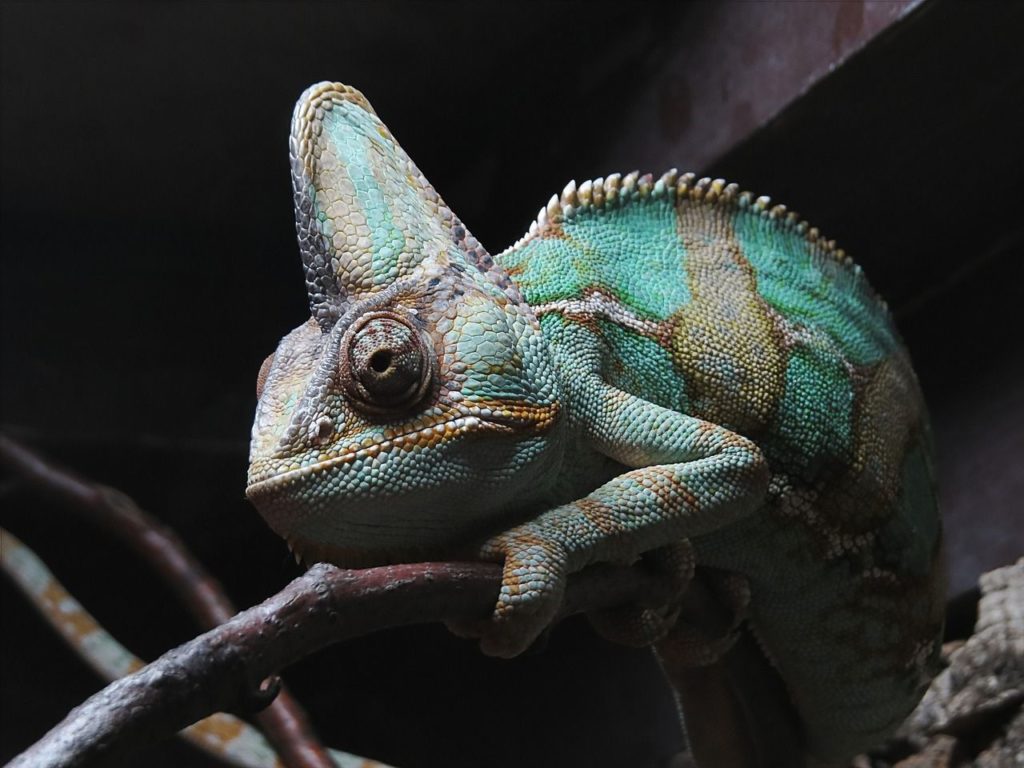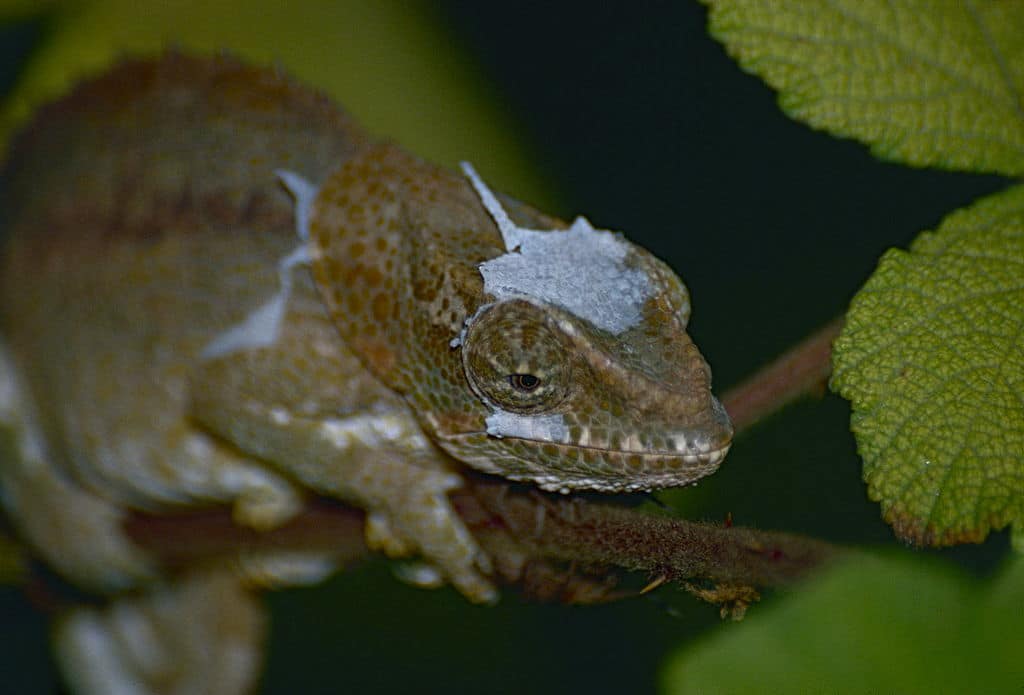True chameleons of the Old World are a very unusual collection of lizards, who exhibit a number of bizarre adaptations.
To an extent, these adaptations are key to the lizards’ popularity, but it also means that these lizards are more challenging for keepers to maintain than many other types of lizards.

One great example is the shedding process. Chameleons shed in much the same way than other lizards do, but because of their elaborate habitat and husbandry needs, shedding difficulties are common.
And while a single poor shed is generally not a huge problem, repeated shedding problems can lead to issues. Moreover, persistent problems like this can indicate that your lizard is not adapting well to the habitat you’re providing.
We’ll try to help you avoid these kinds of problems below, as we share some tips for helping your lizard enjoy complete, problem-free sheds on a regular basis.
Quick Navigation
Understanding the Chameleon Shedding Process: The Basics

The shedding process for chameleons unfolds much as it does for other scaled reptiles. There are a few differences (mostly caused by the unusual anatomy of chameleons), but by-and-large chameleons shed like corn snakes, leopard geckos or green iguanas do.
- Chameleons have several layers of skin. Just like humans and other animals, chameleons have several layers of skin. It is the oldest layer – the one on the surface – that is shed regularly. This reveals newer, younger skin beneath, which is the reason why chameleons often look particularly colorful after shed cycles.
- Chameleons shed for multiple reasons. Shedding allows for the regular replacement of damaged, old or worn-out scales and skin, and it also allows the “breathing room” necessary for the lizard to grow. Shedding also serves as a form of “bathing” (the jettisoned skin simply falls off and takes the dirt with it), and it helps rid the lizard of ectoparasites like mites or ticks.
- Chameleons tend to shed in numerous pieces. Unlike snakes, who generally shed in one long piece, chameleons (like most other lizards) tend to shed in a number of smaller pieces.
- Shedding may trigger behavioral changes in your lizard. Some lizards become irritable or nervous during the shedding process. Shed cycles can also alter the way your lizard behaves – your pet may bask more or less often, drink more water than usual or refuse food until after he sheds.
- Shedding takes place over a period of time. Obviously, shedding isn’t an instantaneous process; it occurs as a cycle that begins many days before the lizard actually begins ridding himself of the old skin. It’s difficult to identify a precise time at which the cycle starts, but one of the first things that occurs is a layer of fluid builds up between the oldest layer of skin and the one directly beneath it. This is the time during which many reptile’s eyes turn blue or grey, but this is rarely observed in chameleons, thanks to their unique eye anatomy.
- Shedding occurs most frequently in young chameleons. Because shedding is directly related to growth, young chameleons – who enjoy the fastest growth rates of their lives – may shed as often as every few weeks. Older, larger chameleons often shed only a few times a year, given that they are not growing very much.
- Shedding also occurs in response to several different occurrences. Regular sheds occur primarily in response to growth and as the overall replacement of worn-out skin cells. However, chameleons may also shed in response to things like injury or illness. Shedding is also associated with the breeding cycle in mature individuals.
Bad Sheds: What Can Go Wrong?
Unfortunately, shedding does not always proceed smoothly for chameleons (or any other reptile). At times, a chameleon may find himself unable to free all parts of his skin, and pieces – occasionally a great many pieces – may remain stuck to the body. And this may lead to serious problems for your lizard’s quality of life.
For example, if skin remains wrapped around your lizard’s toes, it may restrict the blood flow to the affected digit. Left untreated, this may eventually lead to necrosis and the loss of the toe. If this occurs in several toes at the same time, it could lead to the loss of multiple digits. Given the unique layout of chameleon feet and the important role chameleon feet play in their day-to-day lives, this could lead to severe stress, discomfort and, potentially, the inability of the lizard to perch and live a normal life.
Retained skin on the tail tip can lead to similar problems, and skin that remains stuck near the eyes or mouth may result in blindness or mouth rot, respectively. If large portions of skin continue to cling to the lizard’s body, it may even impair the lizard’s ability to move normally.

The Chief Causes of Problematic Sheds
Now that you understand the problems that poor sheds can cause and undoubtedly see the importance of promoting problem-free shed cycles, it is important to identify the primary causes of shedding problems in chameleons.
- Insufficient Humidity – Dry air can prevent a sufficient fluid layer from developing between the chameleon’s skin layers. This, in turn, can lead to poor sheds. Additionally, it can cause chameleons to become dehydrated or suffer respiratory infections.
- Dehydration – Chameleons who fail to drink enough water (usually because the keeper fails to provide drinking water regularly or in a form the chameleon recognizes) will have similar problems to chameleons who are kept in excessively dry conditions.
- Stress – Stress is capable of triggering an enormous variety of health problems, ranging from respiratory infections to inappetence. It can also cause chameleons to shed poorly, so it is imperative that you maintain a low-stress environment for your pet.
- Illness – Illness can sometimes lead to poor sheds. However, once the illness passes, your lizard will usually begin shedding properly again – you just need to make sure that you address whatever medical problem occurred in the first place.
- Injuries – Injuries (particularly those that involve your pet’s skin) can make it difficult for your lizard to shed properly. They may also involve skin lacerations, which will make your lizard more likely to shed in a number of very small pieces, rather than fewer, larger ones.
- Parasites – Mites and other external parasites often trigger shedding difficulties, so it is important to regularly inspect your pet for any signs of biting bugs.
While the issues discussed above are undoubtedly the most common reasons for poor sheds, there are other, less-common reasons why chameleons will occasionally experience bad shedding cycles. However, determining the cause of these unusual cases will often require the assistance of your veterinarian or a more experienced keeper. So, as always, don’t hesitate to seek help when necessary.
Tips for Encouraging Problem-Free Sheds
Understanding the reasons chameleons can experience shedding difficulties is a good first step in avoiding these issues, but you’ll need to implement a few strategies to help reduce the likelihood that you’ll see skin clinging to your pet’s body at all.
To that end, we offer the following tips and tricks:
- Purchase and use a hygrometer. Fledgling keepers often have trouble assessing the humidity level in their pet’s enclosure. And given the importance of a properly humidity level for chameleons, it is wise for all keepers – especially new ones – to purchase and install a hygrometer.
- Experiment with the ventilation of your pet’s habitat. Proper ventilation is crucial for chameleon maintenance, as they don’t thrive in stagnant conditions. However, excessive ventilation will make it challenging to maintain proper humidity levels. Accordingly, you’ll often find it necessary to experiment to achieve the ideal amount of habitat ventilation for your chameleon.
- Watch to ensure your chameleon is drinking water frequently. Because chameleons rarely recognize standing water, they sometimes fail to drink enough water unless the keeper provides the water in an appropriate manner. So, it is vital that you watch when misting or introducing a drip system to ensure your pet drinks water regularly.
- Provide drinking water in multiple ways. In addition to monitoring your pet to ensure he drinks sufficient water, you may want to provide water in multiple ways. You may, for example, want to install a drip system and mist the habitat regularly. You can also spray the vegetables you offer your pet, if he is a member of a species that eats plant material.
- Double-check the enclosure temperatures. Cage temperatures that are excessively high may accelerate the rate at which your chameleon loses water. This will lead to dehydration, which, in turn, can cause shedding difficulties. So, you’ll want to be sure you use a high-quality digital thermometer.
- Constantly monitor your chameleon for signs of illness. As mentioned earlier, illness can cause shedding problems for chameleons. Accordingly, you’ll want to monitor your chameleon for the subtlest signs of illness and take immediate action if you believe he is sick.
- Take steps to prevent parasites from afflicting your pet. As long as you start with a captive-bred animal purchased from a high-quality source, your lizard probably won’t have any parasites at the outset. However, if you don’t employ strict hygiene and quarantine measures, you may inadvertently bring parasites back home to your lizard.
- Inspect your pet’s habitat and ensure that safety hazards aren’t present. Injuries can prevent your lizard from shedding properly, so make a practice of inspecting your pet’s habitat regularly for anything that may cause wounds and addressing these issues promptly.
- Avoid handling your pet unnecessarily. Chameleons do not tolerate handling very well, and excessive interaction with your pet can lead to high stress levels. Because these high stress levels can disrupt the shedding process, it is imperative that you don’t handle him too frequently or for too long.
- Ensure that your pet’s habitat has plenty of visual barriers and places to hide. Along with the importance of avoiding excessive handling, you’ll also want to make sure your pet always has plenty of visual barriers (which will serve as hiding places) in his enclosures. Including plants – whether live or artificial – in the enclosure is typically the best way to do so.
Conclusion
If you follow the tips above and provide suitable care for your pet chameleon, you should be well on your way to one good shed after another. Just remember to keep your specific species’ requirements in mind and try to provide the ideal habitat conditions at all times.
If, after embracing the tips mentioned above, your lizard continues to have trouble shedding properly, be sure to contact your veterinarian. It would also be a good idea to have a more experienced chameleon keeper check out your enclosure and care regimen. He or she may be able to point out mistakes that you never knew you were making.
And this may be all you need to help your lizard enjoy better shedding cycles.